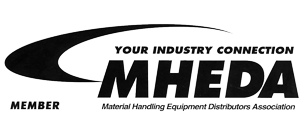How to Prep Your Forklift for Winter Weather
January 20, 2021
Winter weather can be tough on material handling equipment. Dry air paired with freezing temperatures makes for a less than ideal situation.
Luckily, there are steps you can take to prepare your forklift for winter. Protecting your forklift now will help you avoid expensive repairs down the road. Take the time to properly prep your forklift for inclement weather.
Forklift Inventory can help you get ready for the colder months ahead. Learn more about winter forklift maintenance here.
6 Forklift Maintenance Tips for Winter
We’ve compiled a list of six simple tips to follow. Many of these areas can be checked daily during your pre-operational check. Check out our blog on how to incorporate a forklift daily checklist here.
1. Battery
Cold temperatures can reduce battery capacity. In fact, electric forklift cycle times can decrease up to 25-50% in the winter. The weather affects the battery’s electrolyte, making it harder for it to perform the chemical reaction needed to power your equipment.
The best solution for battery protection is to park your forklift in a dry, insulated area. Be sure to inspect your forklift regularly and clean any exposed cables. Also, test your battery regularly with a load tester to ensure that it’s close to maximum strength. Get additional battery maintenance tips here.
2. Hydraulics
Hydraulic systems are also affected by cold weather. It’s important to keep all moving parts well-lubricated to avoid rusting. Brittle joints can cause pieces to break.
3. Safety Features
Operating in the winter is dangerous. Days are shorter and darker. Wind and snow are common. All of these factors make operating material handling equipment much more difficult.
Every time you perform a pre-operational check, be sure to test all of the forklift safety features, including the brakes, horn, and seat belts. Also, check that the lights are providing enough visibility. Consider switching to LED lights if you’re still using halogen lighting. Always follow proper forklift safety procedures.
4. Tires
Forklift tires lose pressure more quickly when it’s cold. Be sure to check tire pressure frequently if you used air-filled tires. In addition, check your tire treads to ensure that they are deep enough to handle slippery conditions. On the same note, encourage operators to wear proper footwear to avoid slipping.
5. Cooling System
Routinely check antifreeze levels with a hydrometer during the winter. Check hoses for leaks. The last thing you want is forklift parts frozen together.
6. Cab
Lastly, you might want to make sure your cab is properly sealed (if it’s enclosed). This is not only for comfort but also for forklift care. If moisture gets into the cab, it can damage the controls. Also, make sure the windshield wipers are effective and replace them if not.

Running a Smooth Winter Operation
Winter weather definitely requires extra diligence and preparation on your part. However, no matter how cautious you are, you can’t operate safely if your equipment itself is unsafe.
If your forklift is spending more time in the shop than in operation, it may be time for a replacement. If this sounds like you, turn to Forklift Inventory. We can help you find the best deal on equipment in your area.
Simply let us know what specifications you’re looking for by filling out this short form. Then, we’ll send you free quotes on forklifts that meet your needs.
Find the Best Deal on Quality Forklift Equipment.
Compare Forklift Prices
Forklift Inventory has the largest online selection of forklifts, aerial lifts and construction forklifts. Compare new and used forklifts to get the lowest prices available.




